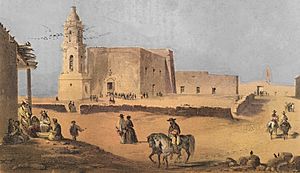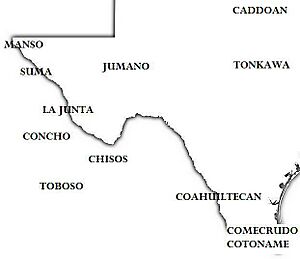Manso people facts for kids
The Manso Indians were a group of Native American people who lived along the Rio Grande river. They lived there from the 1500s to the 1600s. The city of Las Cruces, New Mexico is now in the area where they once lived.
The Manso were one of the groups moved to the Guadalupe Mission. This mission is in what is now Ciudad Juarez, Mexico. Some of their family members still live in that area today.
The Mansos were semi-nomadic, meaning they moved around a lot. They were hunter-gatherers, finding their food by hunting animals and gathering plants. They did very little farming. Their way of life was like that of the Suma and Concho people who lived nearby.
Contents
What Language Did They Speak?
We only know a few words of the Manso language. Experts who study languages think it might have been an Uto-Aztecan, Tanoan, or Athabaskan (like Apache) language.
We do know they spoke the same language as the Jano and Jocome people. These groups lived to their west. It was most likely a Uto-Aztecan language. This language was related to the Cahitan languages spoken in northwestern Mexico.
Manso History: Early Encounters
The first written record of the Manso people comes from a Spanish explorer. Antonio de Espejo wrote about them in January 1583. He was traveling up the Rio Grande looking for the Pueblo Indians. Espejo met a group he called Tampachoas below El Paso.
He wrote that he found many people living near lagoons. The Rio Grande flowed through these lagoons. He estimated there were over a thousand men and women. They lived in their camps and grass huts. They came out to greet his group.
The Manso brought gifts of mesquite beans and many kinds of fish. Fish were very common in these lagoons. They also brought other foods. For three days and nights, the Manso danced for the Spanish. They danced in their own style and in the style of the Mexicans.
Another Spanish group, the Chamuscado and Rodríguez Expedition, passed the same lagoons in July 1581. They found no one living there. Historians believe the Manso were nomadic. They probably lived along the Rio Grande only part of the year. The rest of the year, they hunted and gathered food in the nearby deserts and mountains.
They seemed to live along the Rio Grande from present-day El Paso north to Las Cruces, New Mexico. They also lived in the nearby mountains. They might have shared their land with the Suma people. The Suma's history is quite similar to the Manso's.
How the Manso Got Their Name
The people Espejo called Tampachoa were likely the same group. Juan de Oñate met them in the same area in May 1598. He called the natives the Manso. Oñate and his large group crossed the Rio Grande near Socorro, Texas. About 40 "manxo" Indians helped them.
The word "Manso" means "gentle" or "docile" in Spanish. We do not know what the Manso called themselves.
In 1630, a Spanish priest described the Manso. He said they did not have houses, but pole structures. He also said they did not farm. They did not wear much clothing. The men were nude, and the women covered themselves from the waist down with deerskins.
In 1663, another Spaniard wrote about them. He said the Manso were "barbarous and uncultivated." He noted they went naked. Even though the country was very cold, they had no houses. They lived under trees and did not know how to farm for food. The Manso were also said to eat fish and meat raw.
However, they were also described in a good way. They were called "a robust people, tall, and with good features." They liked to cover themselves with colored powder. This made them look very fierce.
Life at the Mission and Challenges

During the 1660s, many Manso people became Christians. The Spanish built a mission for the Manso. The Manso were not a big concern until the 1680s. At that time, people who survived the Pueblo Revolt in New Mexico came to El Paso. The Manso became close with the Piro and Tiwa (Tigua) refugees.
It was probably hard to support the 2,000 Spanish and Native American refugees in the area. The colonists noticed that the Manso living at the Mission caused "trouble." The Apache and Suma, who still lived in the mountains and deserts, also caused trouble.
In 1682, the Governor in El Paso reported that the Manso and Suma had rebelled. They attacked the Janos people. On March 14, 1684, friendly Tiwa and Piro people told the Governor, Domingo Jironza Petriz de Cruzate, about a Manso plan. The Manso wanted to kill all the Spanish people in El Paso. The Manso were said to be "tired of everything having to do with God and with the church." They wanted to do what the Native Americans of New Mexico had done.
The Spanish arrested the leaders of the plot. These included an Apache and a Quivira (likely a Wichita). Ten of these Native Americans were executed. In November, the Spanish army of 60 men, plus friendly warriors, attacked a group of hostile Native Americans. They suspected this group was planning their own revolt.
The Manso Today
After the revolt, the Manso became more mixed in with the people of El Paso. Diseases and raids by the Apache greatly reduced their numbers. Many Manso may have joined the Apache. By 1765, El Paso had 2,469 Spanish people and only 249 Native Americans. The specific tribes of these Native Americans were not mentioned.
However, in 1883, Adolph Bandelier found about a dozen Manso families. They were living across the Rio Grande from El Paso.
Descendants of the Manso have survived. They are members of the combined Piro-Manso-Tiwa (PMT) tribe. They are also members of Tortugas Pueblo. This is a village in Las Cruces, New Mexico. Some Manso people helped start the Guadalupe Pueblo near Las Cruces in 1910. The people of this new pueblo called themselves Los Indigenes de Nuestra Señora de Guadalupe. This tribal group was once part of the Piro-Manso-Tiwa tribe before they separated.
Two groups say they are descendants of the Mission Indians of Paso del Norte. They have asked the U.S. government to recognize them as an Indian Tribe. These are the Piro/Manso/Tiwa Tribe of San Juan de Guadalupe and the Piro/Manso/Tiwa Tribe of Guadalupe. In 2000, there were 206 members of the PMT tribe of San Juan de Guadalupe.
See also
In Spanish: Mansos para niños


